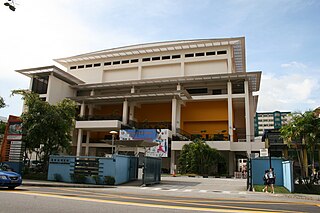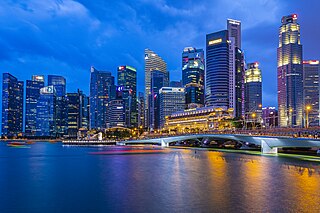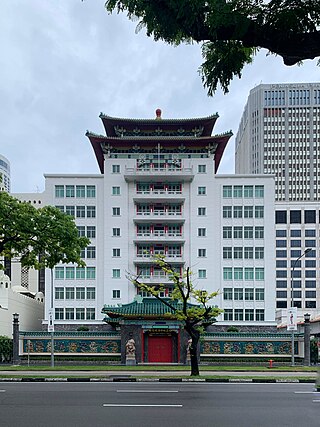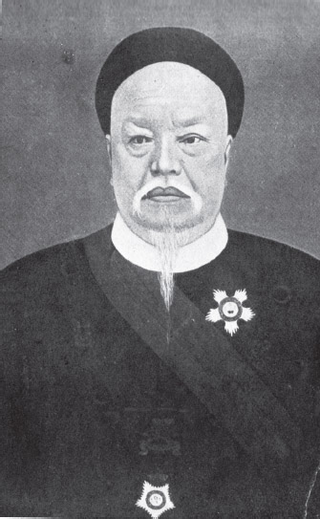
Teochew Building is a historic building on Tank Road in Singapore. Completed in 1963, it jointly houses the Teochew Poit Ip Huay Kuan and the Ngee Ann Kongsi.

Teochew Building is a historic building on Tank Road in Singapore. Completed in 1963, it jointly houses the Teochew Poit Ip Huay Kuan and the Ngee Ann Kongsi.
The land on which the building stands was previously the Tuan Mong High School. [1] The building's construction, which cost millions, began in June 1961 and was expected to be completed by the middle of the next year. The ground floor of the building would be occupied by offices for the Teochew Poit Ip Huay Kuan and the Ngee Ann Kongsi while a large hall and stage with a maximum capacity of 1,000 people could be found on the second floor. The upper three floors was to house the 45 classrooms of the Tuan Mong High School. A $16,000 master clock, which would control the clocks in the classrooms, was to be installed in the central part of the building. The "Peking-style" building was designed by prominent local architect Ng Keng Siang. [2]
On 26 May 1963, the Ngee Ann College was officially opened within the building by Yong Nyuk Lin, then the Minister for Education. Chief Justice of Singapore Wee Chong Jin, Speaker of the Federation of Malaya Parliament Mohamed Noah Omar and Minister for National Development Tan Kia Gan attended the ceremony, while Prime Minister Lee Kuan Yew later attended a reception. [3] The college moved to a larger premises in Clementi a few years later. [4]
In 1995, it was announced that the building was to undergo a $10 million renovation, after which the ground and first floors would be occupied by the Teochew cultural centre. The centre was to be used for various cultural activities, including art exhibitions, displays of Chinese and Teochew artifacts and the staging of Teochew operas. [5] Renovation works had begun by September and were to be completed by 1997. [6] In 1998, the Ngee Ann-Adelaide Education Centre private institution, formed through a partnership between the Ngee Ann Kongsi and the University of Adelaide, was opened in the building. The centre stopped accepting new students on 18 July 2016 after the university decided to end the partnership. [7] The Ngee Ann Kongsi Heritage Hall was established within the building in March 2003 to "commemorate the entrepreneurial and sacrificial spirit of the pioneers of Ngee Ann Kongsi." The hall displays several artifacts and archives detailing the history of the Ngee Ann Kongsi. In April 2004, the Ngee Ann Kongsi Collections Gallery, an art gallery, was opened in the building. [8]
In 2017, the Ngee Ann Kongsi requested the Teochew Poit Ip Huay Kuan to vacate the building to allow for a $40 million redevelopment that was to begin on 1 July 2018. However, the Huay Kuan refused to do so and the ensuing dispute between the two organisations led to the redevelopment being delayed. Both organisations then began filing lawsuits against each other. On 7 December 2023, it was announced that the dispute had come to an end, with both organisations having come to an agreement. [9] As a result, it was decided that the plans for redevelopment, which would involve the building's rear being demolished and replaced by a newer building, would be going forward. [10]
Ngee Ann Polytechnic (NP) is a post-secondary education institution and statutory board under the purview of the Ministry of Education in Singapore.

Ngee Ann City is a shopping and commercial centre located on Orchard Road, Singapore. The S$520 million building was officially opened on 21 September 1993 by then-Prime Minister Goh Chok Tong.

Ngee Ann Secondary School (NASS) is a co-educational government-aided autonomous secondary school in Tampines, Singapore. Founded in 1994 by the Ngee Ann Kongsi, a Teochew clan foundation, Ngee Ann Secondary School is a successor to the now defunct Tuan Mong High School. The school offers secondary education leading to the Singapore-Cambridge GCE Ordinary Level or Singapore-Cambridge GCE Normal Level examination.

The Central Area, also called the City Area, and informally The City, is the main commercial and financial city centre of Singapore. Located in the south-eastern part of the Central Region, the Central Area consists of eleven constituent planning areas: the Downtown Core, Marina East, Marina South, the Museum Planning Area, Newton, Orchard, Outram, River Valley, Rochor, the Singapore River and Straits View, as defined by the Urban Redevelopment Authority. The term Central Business District (CBD) has also been used to describe most of the Central Area as well, although its boundaries lie within the Downtown Core.

Seah Eu Chin was an immigrant from South China to Singapore, later becoming a successful merchant, a prominent descendant of Seah Clan and leader in the Overseas Chinese community.
Tan Lark Sye was a prominent Chinese businessman and philanthropist based in Singapore.

Yueh Hai Ching Temple, also known as the Wak Hai Cheng Bio from its Teochew pronunciation, is a Chinese temple in Singapore located in Raffles Place in Singapore's central business district. The temple, whose name literally means "Temple of the Calm Sea", was the first stop for Chinese immigrants to Singapore in the early 19th century. The temple was gazetted as a national monument of Singapore in 1996. It had also won various awards for its heritage and conservation efforts.

The Singapore Chinese Chamber of Commerce and Industry is a business chamber located in Singapore.
The Teochew people or Chaoshanese, Teo-Swa people or Chaoshan people is an ethnic group native to the historical Chaoshan region in south China who speak the Teochew language. Today, most ethnic Teochew people live throughout Chaoshan and Hong Kong, and also outside China in Southeast Asia, including in Singapore, Malaysia, Thailand, Indonesia, Cambodia, Vietnam, and the Philippines. The community can also be found in diasporas around the world, including the United States, Canada, Australia, New Zealand, and France.

Singapore Hokkien Huay Kuan (SHHK), or the Singapore Hokkien Association in English, is a cultural and educational foundation. It was established in 1840 to promote education, social welfare and the preservation of the Chinese language and culture among Chinese Singaporean and other Overseas Chinese groups in Southeast Asia. As of 2014, the SHHK, which has 5000 members, is the largest clan association in Singapore.
The Ngee Ann Kongsi is a charitable foundation in Singapore and governed by the Ngee Ann Kongsi Ordinance of 1933. It is one of many Overseas Chinese Kongsi, or clan associations, that were set up by immigrants from China in the late 19th century.
Teochew Poit Ip Huay Kuan is a Teochew clan association in Singapore. Poit Ip, which means eight districts in the Teochew dialect, stood for the eight Teochew districts in the province of Guangdong, China. Huay Kuan means "clan association". On 12 December 1928, there was a temporary committee convened a meeting at the Tuan Mong School in preparation of the formation of the Huay Kuan. On 20 March 1929, British colonial authorities exempted the Teochew Poit Ip Huay Kuan from registration, and it was formally established.

Major China Dato' Tan Hiok Nee, also known as Tan Yeok Nee, was the leader of the Ngee Heng Kongsi of Johor, succeeding Tan Kee Soon in circa 1864, he transformed the Ngee Heng Kongsi of Johor from a quasi-military revolutionary brotherhood, based in the rural settlement of Kangkar Tebrau, into an organisation of kapitans, kangchus, and revenue farmers, based in the state capital of Johor Bahru. His grandson Tan Chin Hian, was the chairman of the Singapore Chinese Chamber of Commerce, Singapore Teochew Poit It Huay Kuan and Ngee Ann Kongsi Singapore for many years.
Ngee Heng Kongsi of Johor was a Teochew secret society that founded the earliest Chinese settlement in Johor. However, it did not have a clandestine image and has instead been accorded a respectable place in the history of the Johor Chinese. The term kongsi generally refers to any firm or partnership, and has also been used to refer to any group or society in a very broad sense. Ngee Heng is the Teochew name for the Ghi Hin or Ghee Hin, its name in Hokkien. The name identifies it as the Teochew offshoot of the Tiandihui secret society.

School of Science and Technology, Singapore (SST) is a specialised independent school in Singapore, offering a four-year curriculum leading to a Singapore-Cambridge GCE Ordinary Level (O-Levels) or first year entry to a STEM-related diploma course at Ngee Ann Polytechnic (NP).
The Ngee Ann Cultural Centre was set up in 1998 in the Teochew Building in Singapore. It is owned by the Ngee Ann Kongsi and aims to promote Singaporean awareness of Chinese culture, in particular Teochew heritage, through the medium of visual and performing arts. The Cultural Centre encourages involvement and engagement among the Singaporean Teochew community and its artists through Chinese calligraphy and brush painting as well as Teochew opera, dance, music, and drama. The Cultural Centre also supports artists and performers by offering exhibition space, facilities, and organisational resources for local and international artistic and cultural activities.
Tan Siak Kew was a prominent businessman, a member of the Legislative Assembly of Singapore, the president of the Singapore Chinese Chamber of Commerce and a diplomat.
The Singapore Federation of Chinese Clan Associations is an umbrella organisation for ethnic Chinese clan associations in Singapore.

Ng Keng Siang was a pioneering Singaporean architect. He designed several buildings which have since become local landmarks, including the Asia Insurance Building, which was the tallest structure in Singapore at its completion, and the Nanyang University. He was the founding president of the Society of Malayan Architects.
Ngee Ann Building was a building on Orchard Road in Singapore housing both shops and apartments. Built by the Ngee Ann Kongsi and opened in 1957, the rent collected from the building enabled the organisation to establish the Ngee Ann College. It was demolished in 1985 to make way for Ngee Ann City.